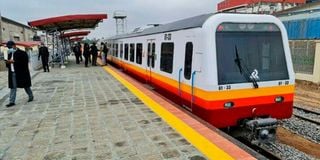Inside Kenya Railway city decongestion plan

One of the Diesel Multiple Units (DMU) at the Nairobi Central Railway Station.
What you need to know:
- The city commuter system will have the capacity to handle 60 million passengers.
- The city commuter rail service development project is part of Nairobi Metropolitan Transport Master Plan.
The days when you wasted countless man hours in traffic jams in Nairobi is soon becoming a thing of the past as Kenya Railways moves to enhance the Nairobi Commuter Rail Service (NCRS).
NCRS is an ambitious programe by the Kenya Railways, a state corporation, which will ultimately be the panacea to the Matatu transport chaos, impunity and disorder that have ruled the public transport system making the lives of daily commuters a real bad experience.
The introduction of the city commuter system with modern and efficient rail infrastructure and passenger trains will have the capacity to handle 60 million passengers annually once completed in the coming months.
In all these undertakings, the Kenya Defense Forces (KDF) and the National Youth Service (NYS) have come in handy to refurbish the railway lines within and outside the city.
Kenya Railways Managing Director Philip Mainga says that the two government institutions have showcased how the government can comfortably manage the railway repairs in a move he says has saved billions of public funds.
“The main idea behind what the government under the leadership of President Kenyatta wants to accomplish is to decongest the roads and bring a smile to the faces of many city commuters,” Mr Mainga says noting; “already things are working.”
Since 2019, reforms at the Kenya Railways have been ongoing.
On November 10, 2020, President Uhuru Kenyatta commissioned the refurbished Nairobi Central Railway station under the modernization programme of the Nairobi commuter rail service.
In undertaking the commuter rail service, the Kenya Railways managing director says that the state agency has spent less than Sh5 billion to transform the city transport system into a positive story that it is now.
Diesel Multiple Units
The works included refurbishment of the 250 kilometers railway transport feeding the city, including the Konza line in Makueni and the rehabilitation of the stations across the country, consuming Sh3.6 billion.
The purchase of 11 Diesel Multiple Units (DMUs), Mr Mainga says, cost the taxpayer Sh1.2 billion.
A DMU requires no separate locomotive as the engines are incorporated into one or more of the carriages.
Mr Mainga notes that before the funds were invested in the city commuter rail project, feasibility studies were undertaken to define the scope, technical details and development structure, and is now at the implementation stage.
“This is part of our last mile project that entails decongesting the city and making it business friendly. Already the demand has gone up which means that every one hour we will have our trains moving,” notes Mr Mainga.
The city commuter rail service development project is part of Nairobi Metropolitan Transport Master Plan.
Once fully inaugurated, the plan is to interlink all the country’s transport points.
It will link the port of Mombasa through the Sh327 billion Mombasa- Nairobi Standard Gauge Railway (SGR) line that has a terminal at the Inland Container Depot (ICD) in the city’s Embakasi area.
It will also offer a linkage to the country’s airports and the road transport network through the Bus Rapid Transport (BRT) system.
Easing transport to the country’s Jomo Kenyatta International Airport (JKIA) will lead to the development of a new 6.5 kilometre railway line from the Nairobi Central Railway station to the airport, further cementing Nairobi’s position as the commercial hub of East Africa and beyond.
Rail commuter project
The modernization of the Nairobi Central Station has led to the construction of a world class central ticketing system and a cafeteria.
Already a facility has been provided at the central station to afford passengers an opportunity to check their local and international flight arrival and departure schedules, BRT buses and SGR departure plans at Syokimau station.
The BRT buses charge a maximum fare of Sh50 from the railway station to points of destination.
Currently the BRTs are operating in the Westlands, Yaya centre, Pangani, Industrial Area and Kenyatta with plans already underway to extend the services to the city’s other routes.
To ensure success of the city rail commuter project, Kenya Railways is carrying out modernization and expansion of the underutilized railway transport infrastructure facilities within Nairobi in order to attract passenger traffic from the Matatu dominated roads.
This includes modernization of stations and rolling stock, upgrading track and signaling systems as well as introduction of new stations in Buru Buru, Pipeline, Umoja, Githurai and Donholm.
The net effect of this, other than reducing congestion in the city, is to create an efficient and affordable mass rapid transit transport system for the city.
This will see passengers increase from the current five million per year to 15 million in the initial stages of the infrastructural rehabilitation project to 60 million passengers per year during the first phase.
This is aimed at integrating rail transport with other modes of transport- road and air- making commuter services in the city, cost effective and coordinated.
Affordable transport
The NCRS project therefore, aims at providing passengers with safe, reliable and affordable transport services in and around Nairobi city.
“Kenyans may not know but what is happening is that Nairobians lose more than 1000 steps a day walking backwards because of the congested space in our city,” says Mr Mainga.
He notes that once the works are complete, the commuter rail services will be close to the best in the world.
While using the NCRS services, commuters will only be required to pay Sh100, though a majority of commuters have complained that it is on the higher side.
“This amount is the least we can afford so that commuters get safe and reliable services. Travelling in comfort and without the numerous disruptions as is the case with the Matatus is what is guiding us,” the MD says.
Kenya Railway is currently modernizing approximately 100 km of track and infrastructure on four major routes radiating from the Nairobi Central Business District (NCBD).
This will be followed by the introduction of modern rolling stock for efficient transport.
The development of the NCRS was based on the fact that Nairobi is the largest city in Kenya and a major transit point in the East African region with at least 1.5 million people commuting per day.
It should also not be forgotten that 85 percent of Nairobi’s population do not own automobiles and commute by public transportation.
The NCRS project will be developed in three phases.
Commuter rail services
Phase 1 is being developed within the existing rail corridors to provide commuter rail services between the Nairobi Railway Station and Ruiru, Syokimau, JKIA, Kikuyu and Embakasi Village.
Mr Mainga notes that the old Embakasi line was uprooted and a new one constructed.
“It is a strong line that will serve the people of Embakasi village for many years to come,” he says.
The phase 1 development entails the building of 26 new modern passenger handling stations at the existing railway stations and at new locations.
Syokimau, Makadara and Imara Daima railway stations are complete and operational.
Phase 2 of the project comprises new links to the city that are within the existing railway transport corridor.
This will extend commuter rail services to Thika, Limuru and Lukenya. Phase 3 development will be within the new railway corridors and will target the outlying satellite towns of the Nairobi metropolis.
The targeted towns include Ongata Rongai, Kiserian, Ngong, Kiambu, Ruai and Kangemi.
“We are introducing the concept of park and ride where Kenyans will only be required to pay Sh100 full day packing in these towns and pick the train to work in the city and back,” Mr Mainga says, noting that it is already happening in Syokimau and Kikuyu.





